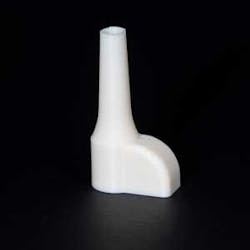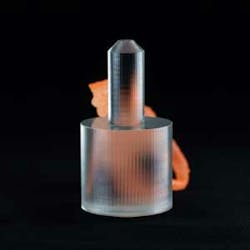Q&A: Enhancing Performance and Versatility with Advanced 3D Printing Materials
As additive manufacturing and 3D printing continues to shift from prototyping-only to extensive part production, advanced 3D printing materials give design engineers the flexibility, reduced production costs and sustainable tools they need to rapidly create new products.
Advanced materials have characteristics such as high strength, heat resistance, conductivity and flexibility, which are suitable for industries such as automotive, medical devices, fixtures and aerospace.
Fictiv recently launched 14 materials for 3D printing, so Machine Design reached out to Riley Hall, a mechanical engineer and product marketing director at Fictiv, to learn about the materials and the company’s platform. Below is the abridged Q&A:
Machine Design: What sets these 3D printing materials apart from others on the market, and how do they specifically benefit design engineers in the additive manufacturing realm?
Riley Hall: It’s an exciting time to be in 3D printing as it continues to evolve from prototype-only uses to large volume parts production. Our release of 14 new 3D printing materials creates more opportunities for advanced engineering applications suitable for production use cases. 3D printed parts are increasingly used in automotive, consumer products, medical devices, functional assemblies, jigs, fixtures and more.
What sets these materials apart is the wide array of innovative applications and design flexibility. They range from high-temperature materials such as Ultem 9085, to biocompatible materials such as ABS-M30i, to Somos materials for optical clarity and water resistance. These materials give design engineers the flexibility, low production costs, and innovative and sustainable tools they need to create new products rapidly.
MD: Can you share any examples from the R&D stage where these new materials significantly improved the outcome or efficiency of the design engineering process?
RH: These materials are new on the Fictiv platform, and we’re excited to see how our customers utilize them. While not specific to these materials, we do have a history with customers who have used Fictiv 3D printing to dramatically improve their product development efficiency. One great example is Mira Labs, a company building a smartphone-powered augmented reality system. They needed high-quality, customer-ready units that were production-grade at lower volumes, so they leveraged Fictiv’s Multi-Jet Fusion printing capabilities and were able to meet customer demand more quickly than ever before.
With access to production-grade materials and additive manufacturing, the entire product development process is accelerated.
Because these materials have mechanical properties suitable for end use, engineers can test and iterate with components that are production ready. Because additive manufacturing is far faster than traditional manufacturing processes for low volumes, engineers can design, test and iterate parts faster than ever before. Whether this allows the engineer to pull in project timelines or execute more iterations before launch, there is substantial benefit to the engineering process.
MD: How does Fictiv ensure the quality and reliability of these materials?
RH: Fictiv allows access to manufacturing capabilities and materials through a fast, high-quality, easy-to-use platform. To ensure this, we network with only the best suppliers worldwide, who each undergo rigorous vetting and onboarding processes before they can earn the title of Fictiv Manufacturing Partner. Then our regional operations teams continuously monitor and manage the performance of these partners to uphold our high quality standards.
Similarly, we do not offer new technology or materials on the Fictiv platform until we know it is tried and tested for our customers.
MD: What R&D efforts is Fictiv investing in to continuously improve and expand the range of 3D printing materials for additive manufacturing?
RH: According to a recent survey we conducted in partnership with Dimensional Research, we learned that more than half of manufacturing leaders (58%) are utilizing 3D printing for high-volume production applications.
Additionally, we know that our customers care a lot about sustainability—in fact, 87% say that its importance is increasing. 3D printing technologies present enormous opportunities to help with accelerated time-to-market for production purposes and sustainable manufacturing. So, we are going to continue investing in the expansion of our 3D printing service line with new industrial-grade additive technologies to help our customers achieve their goals.
MD: In terms of sustainability and environmental impact, how does Fictiv approach the development and production of industrial 3D printing materials, and what steps have you taken to address any potential concerns in this area?
RH: We only bring on proven 3D printing materials and technologies with broad market acceptability to maintain our quality standards.
Additionally, it’s important to consider that 3D printing as a process inherently produces less waste than other traditional, subtractive manufacturing processes. By adding material only where it’s needed, we can reduce overall material waste in manufacturing.
MD: How do you collaborate with design engineers and other industry professionals to understand their specific needs and challenges to develop new materials that cater to their requirements?
RH: Every new material or capability we add to the platform is the result of speaking directly with our design engineering customers and industry experts as well as analyzing large data sets from Fictiv’s digital manufacturing platform.
Fictiv has analyzed, quoted and produced millions of parts through its platform and manufacturing network, so we are able to leverage this data as we look to expand our offerings to meet the needs of customers.
MD: What is your vision for the future of industrial 3D printing materials, and how do you see Fictiv contributing to advancements in the additive manufacturing realm in the coming years?
RH: We believe that the market will continue to adopt additive manufacturing not only for prototyping, but for mechanical parts production. According to survey data collected for our State of Manufacturing Report, 96% of leaders report they use 3D printing—60% for prototyping and 58% for high-volume production. And that percentage will continue to grow. It’s why we view our primary role as giving customers access to the latest manufacturing materials and technologies, with trusted quality and guided expertise.
As Design for Additive Manufacturability (DfAM) resources increase, and as additive parts continue to prove their durability and reliability in the field, the sky’s the limit. Fictiv has a commitment to guide and support its customers in the adoption of additive manufacturing, providing not only parts, but resources, training and case studies to ensure confidence of additive manufacturing technologies.
About the Author
Sharon Spielman
Technical Editor, Machine Design
As Machine Design’s technical editor, Sharon Spielman produces content for the brand’s focus audience—design and multidisciplinary engineers. Her beat includes 3D printing/CAD; mechanical and motion systems, with an emphasis on pneumatics and linear motion; automation; robotics; and CNC machining.
Spielman has more than three decades of experience as a writer and editor for a range of B2B brands, including those that cover machine design; electrical design and manufacturing; interconnection technology; food and beverage manufacturing; process heating and cooling; finishing; and package converting.
Email: [email protected]
LinkedIn: @sharonspielman
Facebook: Machine Design
YouTube: @MachineDesign-EBM




